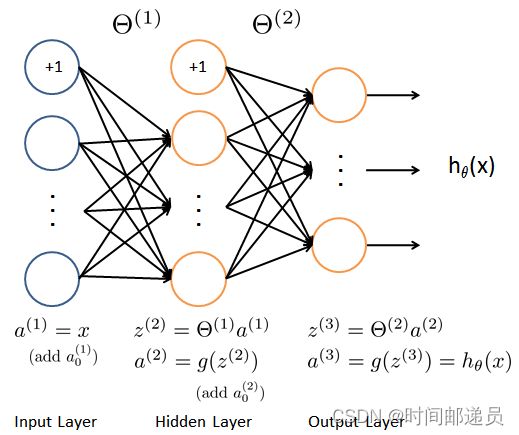多类分类实战
一、题目
自动识别手写数字在今天被广泛使用——从识别邮件信封上的邮政编码到识别银行支票上所写的金额。在本练习中,您要实现根据逻辑回归和神经网络来识别手写的数字的功能
二、多类分类
数据集说明
本次我们的数据集包含5000个手写数字的训练示例,数据格式为mat,mat格式意味着数据被保存为矩阵格式,而不是像csv文件那样的文本(ASCII)格式。我们可以通过使用loadmat命令直接把这些数据读取到程序中,数据被加载后,正确的维度和值的矩阵将出现在程序的内存中,该矩阵将已经被命名,因此我们不需要为它们指定名称,大家可以debug看看
导入依赖
import numpy as np
import pandas as pd
import matplotlib.pyplot as plt
from scipy.io import loadmat
加载数据
def load_data(path):
data = loadmat(path)
X = data["X"]
y = data["y"]
return X, y
X, y = load_data('ex3data1.mat')
# 查看y的标签数量
print(np.unique(y))
# 查看X,y的形状
print(X.shape, y.shape)可以看到一共有5000个训练样本,每个样本是20 ∗ 20像素的数字灰度图像,每个像素用一个浮点数表示该位置的灰度强度,20×20的像素网格被展开成一个400维的向量,矩阵X可表示为:
可视化数据
def plot_an_image(X):
# 从[0,5000)中随机选取100个
sample_index = np.random.choice(np.arange(X.shape[0]), 100)
sample_imagex = X[sample_index, :]
# image (100:400)
fix, ax_array = plt.subplots(nrows=10, ncols=10, figsize=(8, 8), sharey=True, sharex=True) # 行列下标从0开始
for row in range(10):
for col in range(10):
ax_array[row, col].matshow(sample_imagex[row * 10 + col].reshape(20, 20),
cmap='gray_r') # 重塑第row*10+col个图形为20*20的形状,并且设置为黑体白框(gray是白体黑框)
# 去掉x,y轴刻度
plt.xticks([])
plt.yticks([])
plt.show()
plot_an_image(X)向量化逻辑回归
我们将使用多个one-vs-all(一对多)logistic回归模型来构建一个多类分类器,由于有10个类,我们需要训练10个独立的分类器。为了提高训练效率,我们采用向量化来解决问题,在本节中,我们将实现一个不使用任何for循环的向量化的logistic回归版本。
向量化代价函数
我们将从编写代价函数的一个向量化版本开始,回想一下,在正则化的逻辑回归中,代价函数为:
首先我们对每个样本 ![]() 要计算下列函数:
要计算下列函数:
事实上我们可以对所有的样本用矩阵乘法来快速的计算,让我们如下来定义 X 和 θ :
然后通过计算矩阵积 Xθ,我们可以得到:
def sigmoid(z):
return 1 / (1 + np.exp(-z))
def regularized_cost(theta, X, y, l):
"""
don't penalize theta_0
args:
X: feature matrix, (m, n+1) # 插入了x0=1
y: target vector, (m, )
l: lambda constant for regularization
"""
thetaReg = theta[1:]
first = (-y*np.log(sigmoid(X@theta))) + (y-1)*np.log(1-sigmoid(X@theta))
reg = (thetaReg@thetaReg)*l / (2*len(X))
return np.mean(first) + reg
向量化梯度
回顾前面的正则化梯度下降:
所以梯度表示如下:
def regularized_gradient(theta, X, y, l):
"""
don't penalize theta_0
args:
l: lambda constant
return:
a vector of gradient
"""
thetaReg = theta[1:]
first = (1 / len(X)) * X.T @ (sigmoid(X @ theta) - y)
# 这里人为插入一维0,使得对theta_0不惩罚,方便计算
reg = np.concatenate([np.array([0]), (l / len(X)) * thetaReg])
return first + reg
一对多分类器
这部分我们将实现一对多分类,对于这个任务,我们有10个可能的类,并且由于logistic回归只能一次在2个类之间进行分类,每个分类器在“类别 i”和“不是类别 i”之间决定, 我们将把分类器训练包含在一个函数中,该函数计算10个分类器中的每个分类器的最终权重,并将权重返回,shape为(k, (n+1))数组,其中 n 是参数数量
from scipy.optimize import minimize
def one_vs_all(X, y, l, K):
"""generalized logistic regression
args:
X: feature matrix, (m, n+1) # with incercept x0=1
y: target vector, (m, )
l: lambda constant for regularization
K: numbel of labels
return: trained parameters
"""
all_theta = np.zeros((K, X.shape[1])) # (10, 401)
for i in range(1, K+1):
theta = np.zeros(X.shape[1])
y_i = np.array([1 if label == i else 0 for label in y])
ret = minimize(fun=regularized_cost, x0=theta, args=(X, y_i, l), method='TNC',
jac=regularized_gradient, options={'disp': True})
all_theta[i-1,:] = ret.x
return all_theta
上述代码思路:首先我们为X添加了一列常数项 1 以计算截距项; 其次我们将y从类标签转换为每个分类器的二进制值(要么是类i,要么不是类i);然后我们使用SciPy的优化API来最小化每个分类器的代价函数; 最后将优化程序找到的参数分配给参数数组
def predict_all(X, all_theta):
# compute the class probability for each class on each training instance
h = sigmoid(X @ all_theta.T) # 注意的这里的all_theta需要转置
# create array of the index with the maximum probability
# Returns the indices of the maximum values along an axis.
h_argmax = np.argmax(h, axis=1)
# because our array was zero-indexed we need to add one for the true label prediction
h_argmax = h_argmax + 1
return h_argmax
这里的h共5000行10列,每行代表一个样本,每列是预测对应数字的概率,我们取概率最大对应的index加1就是我们分类器最终预测出来的类别,返回的h_argmax是一个array,包含5000个样本对应的预测值
X = np.insert(X, 0, 1, axis=1)
y = y.flatten()
print(X, y)
All_Theta = one_vs_all(X, y, 1, 10)
y_predict=predict(X, All_Theta)
accuracy=np.mean(y_predict==y)
print("accuracy=%.2f%%"%(accuracy*100))三、神经网络
在前一部分中,我们实现了多类逻辑回归来识别手写数字。然而,逻辑回归不能形成更复杂的假设,因为它只是一个线性分类器。在该部分练习中,我们将使用相同的训练集实现神经网络来识别手写数字
模型表示
神经网络如图所示,它有3层:输入层、隐藏层和输出层,其中输入是数字图像的像素值
X, y = load_data('ex3data1.mat')
X=np.insert(X,0,1,axis=1)
y=y.flatten()
print(X.shape,y.shape)
前向传播
a1=X
print(a1.shape,Theta1.shape)
[email protected]
print(z2.shape)
z2=np.insert(z2,0,1,axis=1)
a2=sigmoid(z2)
print(a2.shape)
[email protected]
print(z3.shape)
a3=sigmoid(z3)
print(a3)
y_predict=np.argmax(a3,axis=1)+1#返回每行的最大值的索引
print(y_predict.shape)
准确度计算
accuracy=np.mean(y_predict==y)
print("accuracy=%.2f%%"%(accuracy*100))







